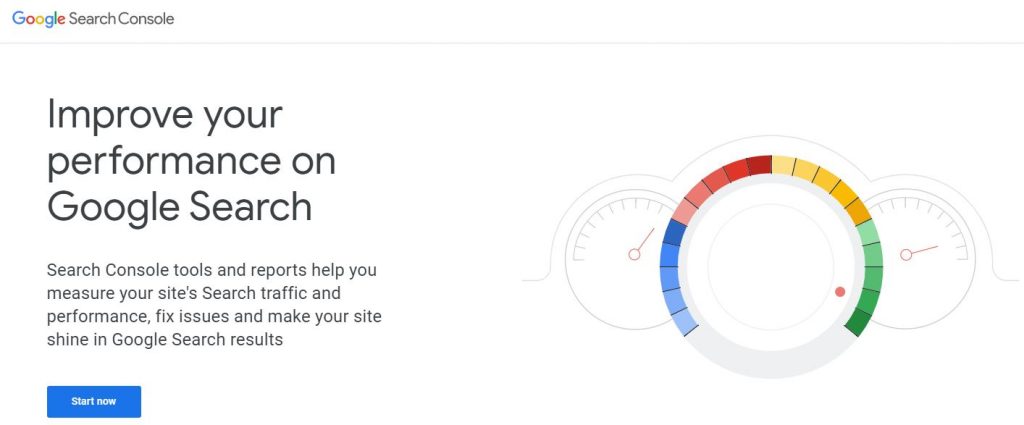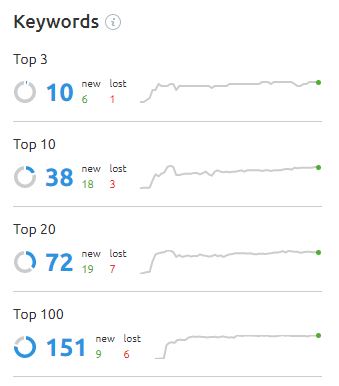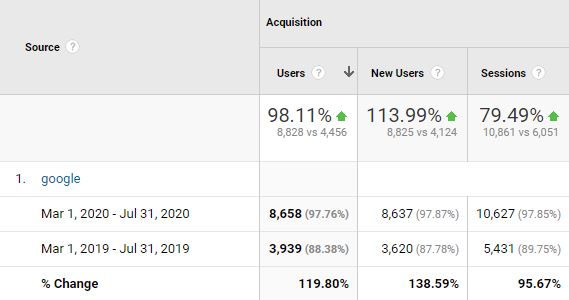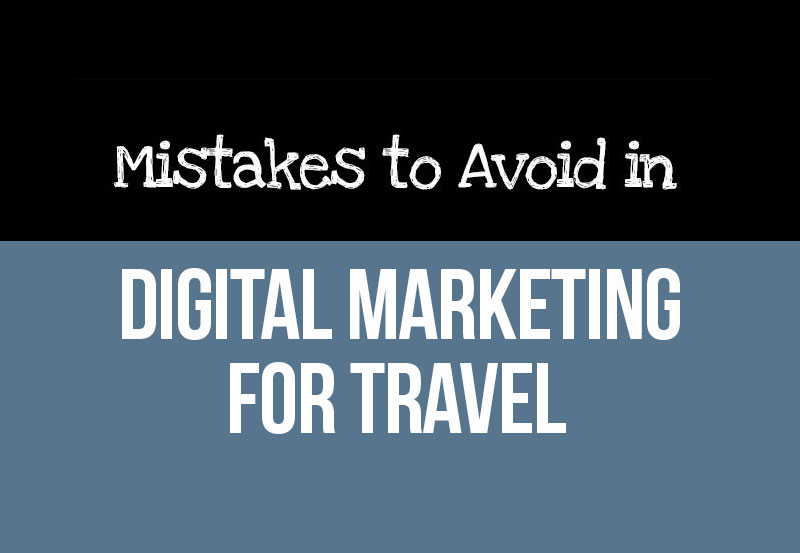SEO Case Study: How to Rank for 10k MORE Organic Keywords in 4 Months!
In this case study we’re going to show you how we implemented a custom strategy for one of our clients, which has increased the number of keywords ranking in Google by over 10,000 in only 4 months!
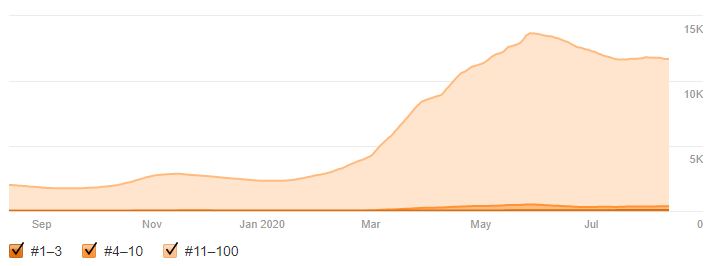
We want to share a process we’ve developed to improve the link profile and Domain Authority (DA) which any business can use to drive more qualified traffic from search engines.
Our case study provides actionable takeaways, following a simple and repeatable SEO strategy.
More site visitors means more impressions, more signups, more purchases — and, importantly, more revenue!
The Challenge
In this case study, we feature a fast-growing travel business offering wildlife and safari holidays worldwide.
The business is run by a team of specialists, who know everything there is to know about turning wildlife dreams into reality.
We began working with the client in March 2020.
The business was keen to improve their overall SEO performance at the start of the outbreak of Covid 19.
They were keen to invest in growing their search exposure in a way which was sustainable and offered long-term value to the business.
Our initial focus is on understanding more about the business, the most important search keywords, and the existing SEO performance.
The business was ranking in top 10 positions for a very limited number of relevant search terms.
The plan was to:
- Use keyword research to identify keyword opportunities.
- Optimise landing pages for key-phrases offering relevance and high search volume.
- Utilise existing content and focus on new content creation.
- Review the existing link profile.
- Develop the link profile of the homepage and other important pages.
- Focus on developing the Domain Authority.
So, if you’re ready, let’s dive into the case study.
Step-By-Step SEO Process
Step 1
Keyword Research
Keyword research is a crucial first step to understanding the current SEO performance and the potential keyword opportunities.
There are a number of keyword research tools which can help you to understand the keywords you rank for currently, and identify keyword opportunities based on search volume.
The most effective free tool is Google Keyword Planner which, provided you are currently running paid PPC ads, gives you exact search volumes for related terms.
The initial focus is on identifying keywords which are considered ‘quick wins’. These are pages ranking just off the first page of Google.
Pages already ranking strongly may simply need to be targeted more specifically on the relevant keyword.
The aim of the process is to identify the most important keyword to target with each landing page.
For each key-phrase will need to consider the average monthly search volume, the level of competition and the conversion intent behind the user’s search.
For example, ‘Kenya Holidays’ has more conversion intent than ‘Kenya’, albeit with much lower search volume.
Focus on defining your niche (i.e. Safari holidays in Kenya)
You can research in 2 key ways:
- Find new keywords
To find new keywords, add words, phrases or your site URL related to your business and you’ll get the following data:
Exact monthly search volumes (or volume range depending on PPC spend)
Level of competition
Top of page bid (the equivalent cost-per-click through Google AdWords)
- Get search volume and forecasts
If you have a pre-existing keyword list, you can upload the list into Keyword Planner to identify those with the highest search volume.
The more keywords you have to review, the more informed your on-page decisions will be.
Look to identify as many relevant target keywords with search volume as is possible before moving onto step 3.
Step 1 – Summary
- Keyword research is key to effective SEO
- Identify keywords offering strong search volume
- Look for keywords with conversion intent (i.e. ‘safari holidays’)
Step 2
On-site Optimisation
Once a list of relevant target keywords has been identified through the keyword research process, a crucial next step is to ensure that there are unique landing pages created to target each key-phrase.
This involved amending the focus on pre-existing landing pages to ensure these are focused on the most valuable keyword opportunities.
The most important on-page changes relate to the H1 and page title.
These key SEO elements need to be aligned to ensure there is a clear focus on the target key-phrase for each page.
As part of this process, it is important to identify whether there are any keyword cannibalisation issues.
Such issues occour when separate landing pages are optimised for the same target key-phrase.
It is crucial to resolve such issues by ensuring each page has a distinct keyword-focus. This process removes the chances of multiple pages competing with others for the same keyword.
Step 2 – Summary
- Ensure you have a unique landing page targeting each key-phrase
- Ensure the Header 1 (H1) and page title are both targeting the same key-phrase
- Identify and resolve keyword cannibalisation issues
Step 3
Audit Existing Link Profile
It is important to ensure that the link profile of your website is clean.
A toxic link profile may be causing un-told damage to your ability to rank for competitive keywords.
An initial starting point is to review how ‘toxic’ existing links are.
Paid SEO tools such as SEM Rush provide clear visibility as to how to the total number of links to your domain deemed toxic or potentially:
Links need to be manually reviewed to ensure that those being listed for review are in fact poor quality.
Note: Links from niche domains run by specialists with poor understanding of website development can be listed as toxic. Niche-relevance is important to your overall performance, so don’t be too hasty to remove swathes of links at once. This can do more harm than good.
As well as paid tools, you can also review links pointing to your domain using Google Search Console.
Once a list of links to be removed has been agreed, you will need to submit a disavow file.
The disavow file tells Google that although you are aware the toxic links exist, you do not want these links to be considered part of your link profile.
Step 3 – Summary
- Audit existing link profiles – Identify toxic links
- Submit disavow file to Google Search Console
- Treat disavow submission with caution (don’t be over-zealous)
Step 4
Improve Pre-existing Blog Content
Blog content forms an important part of the overall visibility for your domain.
Whilst the aim is to develop your authority with new content, the best place to start is to ensure ALL existing content on your site is representing your business in the best possible way.
The initial aim of the process is to review blog content, which provides 3 main advantages:
- Increased content depth increases the possibility that each article ranks well in search engines.
- Improving the content to include clear calls-to-action (CTAs) ensures that ALL of your content is working hard to convert visitors into enquirers (and hopefully bookers)
- Adding relevant internal links (to appropriate sales-focused landing pages) improves the websites internal link profile, improving SEO performance.
Key steps for improving content involve:
- Adding additional content
- Adding/improving imagery
- Adding/improving calls-to-action
- Adding additional internal links to key sales pages
The main benefits of investing in your existing content is:
- Attracting new users
Once ranking for relevant search terms, blog content can provide a valuable stream of visitors.
Content focused on answering questions relevant to your products, or providing inspiration, will ensure that visitors are similar to your target audience.
- Promoting key pages
As well as attracting new users to the domain, content needs to focus on converting readers into enquirers.
This includes adding clear calls-to-action on blog content and using internal links to promote key sales-focused landing pages.
As we discussed earlier, internal links to these pages will also aid overall SEO performance.
Step 4 – Summary
- Review existing content (landing pages and blog articles)
- Identify additional content requirements
- Add additional content, images and calls-to-action
Step 5
Internal Link Strategy
Isn’t it odd how something as simple as adding a link to another page on your site can help your SEO?
Any content on your should be utilised to promote key landing pages using internal links.
This will both promote relevant product, as well as improve the internal link-profile of important landing pages.
When we started working with the client, there were a few internal links on most of his pages and posts, but there wasn’t a clear strategy behind them.
After completing the initial content audit, there was a focus on adding new internal links and optimizing the anchor text of existing links.
The aim is to add a selection of internal links to other landing pages using anchor text that included either:
- The target keyword of the landing page
- Or, a variation of the target keyword
- Or, a secondary long-tail keyword
The aim was to add links pointing to landing pages which related to the specific blog posts, including destination pages (i.e. Uganda), experience (i.e. Gorilla Trekking) and places-of-interest pages (i.e. Bwindi National Park).
This process ensures the target landing pages benefit from increased SEO authority as well as more exposure to readers of the blog articles.
Step 5 – Summary
- Internal links are an increasingly important part of SEO performance
- Links between related pages is crucial for overall performance
- Use optimised anchor text for internal links (aligned with your target keyword)
Step 6
Link Building
Links from high-authority domains to your website are the most important component in improving your organic performance.
Whilst on-page optimisation ensures that your website is in the best possible position to perform well in search engines, quality in-bound links are a crucial part of highlighting the credibility of your site to Google.
The majority of links (at least at the outset) will need to be directed to your homepage.
This focus ensures that the links improve the overall Domain Authority of the website; helping to improve the ranks for a wide range of pages across your site.
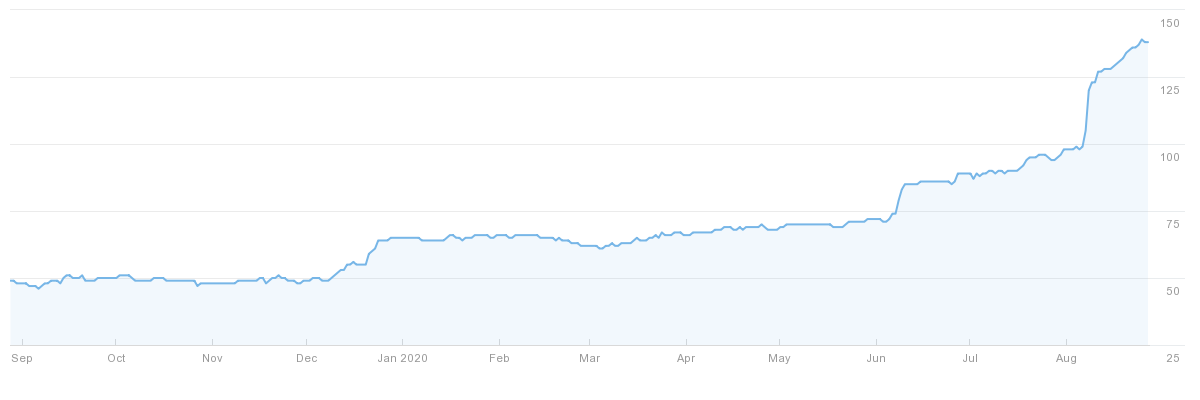
This focus on links to your homepage using branded anchor text (your brand name or URL) is also the safest way to improve your overall SEO performance, whilst also protecting the long-term health of your website.
Moving forward our focus has diversified to include links to specific landing pages to improve the rankings of specific target keywords.
This process is based upon the keyword research process discussed earlier.
Depending on the existing link profile of your website, you may need to look into submitting a disavow file.
Disavowing poor-quality links is an essential part of giving your site the best possible chance of improving your SEO and this played it’s part in the SEO improvements.
Step 6 – Summary
- Focus initially on links to your homepage
- Start by using natural anchor text (brand name and URL)
- Develop links from high-authority domains
- Start with a limited number of links per-month (ensure the link building rate looks natural)
Step 7
Creating SEO-driven content on a regular basis
An important part of long-term SEO performance is regularly publishing new content.
Looking at the search engine performance of news websites, it is clear that Google loves fresh content.
Publishing content on a regular basis means that Google will index content more frequently, and subsequently is more likely to notice improvements to your domain and authority, and hence re-adjust their ranks accordingly.
SEO-driven content refers to content based on the important keyword opportunities relevant to your niche.
A common problem is to write write content then find the most valuable keywords they can find to ‘optimise’ the content for.
New content ideas for blog posts can be found through the keyword research phrase and through taking advantage of your industry-expertise.
- Keyword opportunities
Use keyword research tools to identify keyword opportunities, use Google medium-to-high traffic keywords with low (or medium) competition.
- Questions
Ask your Sales team what questions customers and enquirers are asking.
This is a good way to understand the concerns that you can help to answer.
- Best-of lists
Best-of lists are an effective way of inspiring potential customers and also ranking for competitive keywords.
With the increased word count available with such lists, the articles deliver high levels of monthly search traffic.
Step 7 – Summary
- Content is king – Create fresh content regularly
- The higher your keyword count, the better chance of your pages ranking well in Google
- Focus on answering customer questions and providing inspiration
The Results
Organic Ranking Performance
The number of keywords ranking in top positions has improved dramatically since we started working with the business in March:
The focus on high-quality links to the homepage has delivered an increase in the number of keywords ranking in Google by over 10,000 in only 4 months!
(Source: A Hrefs)
High-authority links to the homepage improves the overall Domain Authority (DA), which is the key reason behind such a clear increase in pages ranking in Google.
The overall DA affects the ranking of all pages, hence this is the most effective way to improve overall organic traffic.
Organic Traffic
As a result of the improvement in organic ranks across a wide range of pages, the monthly organic traffic the website receives has improved dramatically:
Value of Organic Traffic
The value of organic traffic has also increased significantly, proportionate to the increase in traffic:
(Source: A Hrefs)
Talk To Us
Whilst your SEO performance is something which requires a hands-on approach, the best approach is to talk to the experts.
Advice tailored to your website, and your resources is crucial to achieving the best possible ROI from Google search.
Get in touch with us today for a FREE, no-obligation SEO Audit.
This will show your current performance and the potential opportunity through Google Search.
By continuing to use the site, you agree to the use of cookies. more information
The cookie settings on this website are set to "allow cookies" to give you the best browsing experience possible. If you continue to use this website without changing your cookie settings or you click "Accept" below then you are consenting to this.



